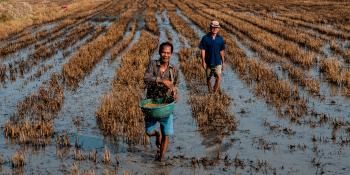Paris Climate Agreement Cannot Be Met Without Emissions Reduction Target for Agriculture

BURLINGTON, VERMONT (17th May 2016) – Scientists have calculated, for the first time, the extent to which agricultural emissions must reduce to meet the new climate agreement to limit warming to 2°C in 2100.
read the paper
Wollenberg E. et al. 2016. Reducing emissions from agriculture to meet the 2°C target. Global Change Biology. DOI: 10.1111/gcb.13340
Scientists from the CGIAR Research Program on Climate Change, Agriculture and Food Security (CCAFS), the University of Vermont, and partner institutions estimate that the agriculture sector must reduce non-CO2 emissions* by 1 gigatonne CO2e per year in 2030. Yet in-depth analysis also revealed a major gap between the existing mitigation options for the agriculture sector and the reductions needed: current interventions would only deliver between 21-40% of mitigation required.
The authors warn that emission reductions in other sectors such as energy and transport will be insufficient to meet the new climate agreement. They argue that agriculture must also play its part, proposing that the global institutions concerned with agriculture and food security set a sectoral target linked to the 2°C warming limit to guide more ambitious mitigation and track progress toward goals.
“This research is a reality check,” comments Lini Wollenberg, leader of the CCAFS low emissions development research program, based at the University of Vermont’s Gund Institute for Ecological Economics. “Countries want to take action on agriculture, but the options currently on offer won’t make the dent in emissions needed to meet the global targets agreed to in Paris. We need a much bigger menu of technical and policy solutions, with major investment to bring them to scale.”
119 nations included mitigation in agriculture in their Intended Nationally Determined Contributions submitted to the UNFCCC. However, no work has been carried out to determine how these pledges will be accomplished.
Agriculture (not including land use change) contributes an average of 35% of emissions in developing countries and 12% in developed countries today. Yet authors warn that efforts to mitigate emissions levels must be balanced with countries’ need to produce enough food, particularly in poorer nations.
“We need to help farmers play their part in reaching global climate goals while still feeding the world,” comments Professor Pete Smith, Theme Leader for Environment & Food Security at the University of Aberdeen and co-author of the paper. “Reducing emissions in agriculture without compromising food security is something we know how to do. A lot can already be done with existing best management practices in agriculture. The tough part is how to reduce emissions by a further two to five times and support large numbers of farmers to change their practices in the next 10 to 20 years.”
To realise the 1 gigatonne CO2ee per year mitigation target for non-CO2 emissions in agriculture set out in the paper, 21-40% of mitigation could be achieved with known practices, such as:
- Sustainable intensification of cattle
- Efficient use of water through alternate wetting and drying in irrigated rice
- Nutrient management for annual crops, including efficient use of nitrogen and manure
- Relocating production to increase input efficiency
However, implementation would require massive investment, information sharing and technical support to enable a global-scale transition.
Even this effort will not be enough, according to the study. Much higher impact technologies and policies will be needed. Promising technical innovations on the horizon include recently developed methane inhibitors that reduce dairy cow emissions by 30% without affecting milk yields, breeds of cattle that produce lower methane, and varieties of cereal crops that release less nitrous oxide.
Policies that support more ambitious mitigation include introducing more rigorous carbon pricing, taxes and subsidies; governments and the private sector adopting sustainability standards that include reduced emissions in agriculture; and improving the reach of technical assistance for farmers on locally relevant mitigation options, for example through cell phone and web-based information portals.
Focusing more attention to sequestering soil carbon, increasing agroforestry, decreasing food loss and waste, and shifting dietary patterns could all contribute significantly to reducing emissions from agriculture, according to the authors. However, much less work has been done on mitigation of emissions from these sources, so action is needed now to identify options and their impacts.
The study "Reducing emissions from agriculture to meet the 2°C target" was first published in Global Change Biology on 17 May 2016.
See the infographic.
Further reading
- Agriculture’s prominence in the INDCs
- Agriculture’s contribution to national emissions
- Mitigation Options Tool for Agriculture
* The study focuses on non-carbon dioxide (CO2) emissions in agriculture such as methane (CH4) and nitrous oxide (N2O), both potent greenhouse gases with significantly higher global warming potential than CO2. Soil carbon was excluded from the analysis because data is highly variable and involves many assumptions related to organic matter inputs, carbon-nitrogen ratios, depth and bulk density, and timing of saturation. Carbon in biomass, such as agroforestry, was also excluded as the global data is comparatively weak.
List of authors:

